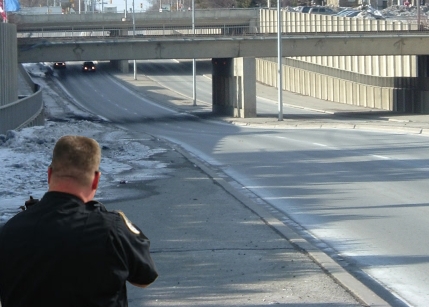- Step 1FIGHT THE TICKET
If you don't want to fight your ticket or go to court, read this section! - Step 2REQUEST A TRIAL
We show you what to do. It only takes 15 minutes. How easy is that! - Step 3PREPARATION
Preparation is the key to success. Do your homework. - Step 4PRE-TRIAL STRATEGIES
Your trial has been scheduled. Now the fight begins. Here's what you need to do. - Step 5TRIAL STRATEGIES
What to do, what to say, and what not to say.
Document The Environment And Conditions
Go back to the offence site and look around. Was the signage clear. Was it blocked by tree branches or mounds of snow?Take photographs of the area if it will be helpful. Make sure YOU take the photograph. If someone else does, then they have to be in court to attest to the particulars (i.e. date and time) of the photograph.
Linear Direction
Are there large metal signs or bridges along the road? Large metal objects affect radar and laser (lidar) gun readings. Was the road flat or were you going down a hill? The radar or laser (lidar) gun has to be on the same vector as your direction of travel.
For example, Cawthra Road in Mississauga is very popular with the Peel Regional Police to operate a speed trap. The officer looks north on Cawthra, just south of the Dundas overpass. The officer will target vehicles just as they emerge from under the bridge and before the driver has a chance to see the trap.

Notice how the road dips, curves slightly and then rises to where the officer is standing. While the officer has a clear view of the vehicles, the direction of travel is not linear toward the officer. A laser gun reading would be suspect and easily attacked for its accuracy. Also notice the large cement bridges which make it difficult to operate a radar gun in this location.
This doesn't stop the police from routinely operating a speed trap here. More than 80% of the tickets they issue will be paid without dispute. A lucrative business by any standard.
Also notice that this is a very unusual place to conduct speed enforcement. This area statistically has an extremely low accident rate. There are no driver distractions (other than the police). Both directions of travel are separated by a wide concrete median and concrete support pillars for the overpass. There are no side streets, driveways, hidden entranceways, crosswalks, schools, or exposed pedestrians.
Measure Distance
Download a satellite image from Google's Map site or streetscape if they have it. It is to scale and will help you measure distance from where the officer was standing and where the road signs are. Be careful, you can't submit these as compelling evidence as you don't know who took it or when so the relevancy for your defence is minimal. However if the distance between the speed sign and where the officer was standing is too short, it draws into question the authenticity of the charge.
For example, if the "60km/hr" sign is 100 metres from where the officer was standing, your vehicle has to pass the 60km/hr sign BEFORE the officer can use his radar or lidar reading for that speed zone. Otherwise you are in a different speed zone. And in order to stop you he has to get you to start slowing down well in advance of where he is standing otherwise you'll run him over. If you are clocked at 100km/hr, you are travelling 27.8 metres per second. That means the officer has just over three seconds to take the reading and stop you before you have passed him. That means he's got less than a second to take the reading, walk out into traffic and raise his hand to stop you. Even then you can't stop a car going 100km/hr in two seconds. More likely, he started clocking you BEFORE you reached the 60km/hr sign which means the ticket is invalid.
Your Ticket
Your Options Demerit Points Insurance Hike Fines Fatal ErrorsOffences
Parking Tickets Stop Signs No Seat Belt

